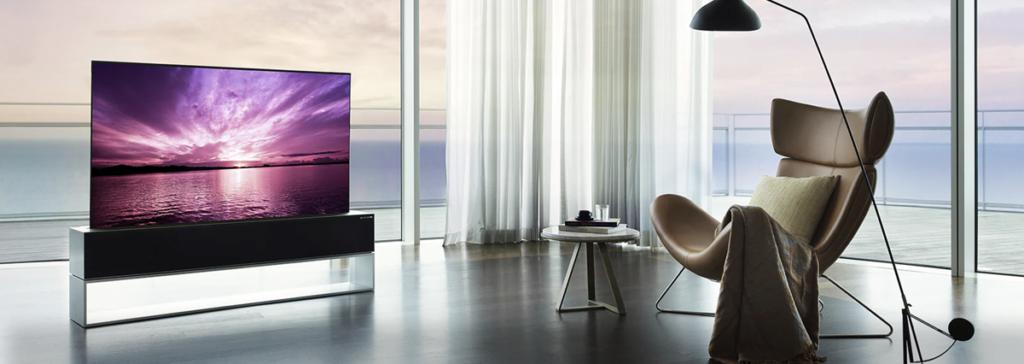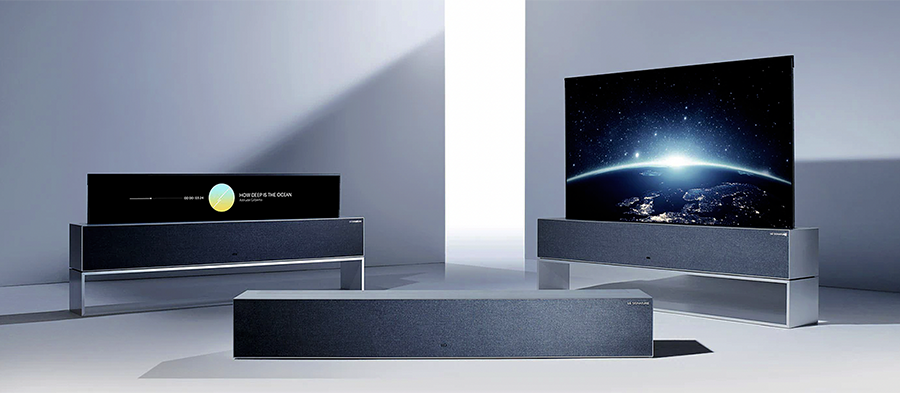Sign up for our monthly newsletter
to stay up to date on Cineluxe
Hand assembled & built to order, LG’s pop-up TV is definitely a technological marvel, but is it a good TV?
by Dennis Burger
December 6, 2021
LG’s new OLED R “rollable” TV is far from merely being a video display. It’s as much an uncompromised design statement as it is an entertainment device. That, plus the fact the finished product takes two months to manufacture and is built to order, with the final assembly process completed by hand, more than justifies its $100,000 price tag.
The OLED R was first teased in 2019, and the delay in releasing it made many wonder if it would ever come to market, but it finally materialized as an actual product a few months ago. So what makes it so special, aside from all the above? For one thing, the display panel is mounted to a flexible piece of glass that literally rolls up—like a window shade—into a beautiful little piece of furniture that also functions as a unique 100-watt sound system with Dolby Atmos capabilities and WiSA wireless connectivity. And it’s a nice panel at that—easily on par with the very best LG produced just a year or so ago.
The OLED R also features three different modes:
• Full View—the fully unfurled position, in which it operates like a normal 65-inch OLED TV, except for the fact that it looks nearly as sexy from the back as it does from the front and has speakers that don’t suck
• Line View—a sort of peekaboo mode in which the display pokes a few inches above the cabinet, just enough to give you a look at the metadata for any music you’re listening to, along with the current time, mood lighting, and your ThinkQ home dashboard
• Zero View—in which the OLED R functions essentially like a 21st-century version of a classic console stereo system.
Of course, given how new the OLED R is, it would be reasonable to suspect that its price tag is simply a consequence of its position on the bleeding edge. After all, just two years ago Samsung sold a 98-inch version of its QLED TV for just a penny shy of the cost of the OLED R; an upgraded version of that same TV now sells for right at $15,000. But there are compelling reasons to believe the LG OLED R won’t plummet in value nearly as fast. Again, it’s not the display here that’s revolutionary—it’s the lift mechanism and the control system integrated into it. And hand assembly to order is likely to remain part of its creation process.
We do have some concerns about the longevity of this untested device, though. Although LG says the OLED panel can be rolled and unrolled 100,000 times (that’s roughly 20 times a day for something like 13 years, which is way longer than anyone keeps a TV these days), the company only backs the panel with a 1-year warranty.
But there’s one thing for certain: The design of LG’s rollable TV isn’t likely to go out of style any time soon.
The LG OLED R: A Designer’s Take
We asked designer Maria Deschamps—who specializes in home theater and media room spaces—to give us her thoughts on the LG rollable TV from an interior design perspective.
What I like about the design is the sleek, minimalist look. It can be integrated into any type of home, whether traditional, transitional, or very modern.
Advantages over a lift system
I love that it’s not as bulky-looking as a typical lift cabinet. Having the speakers integrated into the stand is a huge advantage over a lift! Plus the speakers are Dolby Atmos—LOVE IT! A lift cabinet has to be at least as tall as the height of the TV plus the mechanism that goes below it, so it’s much higher than the LG overall. When you’re seated, you don’t want to have a TV too high; and now that the screens are getting bigger, lowering the overall height of TV is an important consideration.
Placement options
You have a lot more options with the LG; it can be placed in the center of a room or between two rooms. A traditional flat-panel in a lift isn’t attractive from the back—no one wants to walk behind it and see the back of the TV. The LG is visually attractive from 360 degrees, so it can be placed almost anywhere!
Spaces it’s best suited for
A lot of my clients have homes on a beach or looking out on a mountain or a lake. This type of TV can be in front of a window but hidden when they’re not using it so they can still enjoy the scenery they love during “off periods.” It can also be used in open spaces where you don’t have a lot of walls or you’re using your walls for something else like a fireplace or art. The LG is a minimal piece of furniture that magically pops up on demand!
Possible improvements
It would be great to have some options—for example to choose the color/ finish of the base. I’d love to see black, silver, and white finishes—a gold finish would be a real plus! Even wood finishes would be nice. Designers and end-users like options, so it would be nice to be able to choose a style of base—for example, either a pedestal or with legs. It would also be good to have a choice for the base height. As is, it seems perfect for a 65-inch screen in a typical sitting position, but in some cases—for example near a bar table—you might want it higher.
Possible disadvantages
I have concerns about the stability. It’s big, and high, and thin. Does it need to be bolted to the floor? How fragile is the screen? Imagine it’s placed at the foot of a bed (where I can see a lot people using it) and little kids are jumping on the bed and somebody falls into the TV! Does the whole thing fall over? Does the TV break? And although it’s great that it can be placed in the middle of a room, you still have to run cables to it—ideally a floor outlet so the cables aren’t exposed. Any floor outlet has to be planned for in advance, and they’re not that easy to install once the home is already built.
Dennis Burger is an avid Star Wars scholar, Tolkien fanatic, and Corvette enthusiast who somehow also manages to find time for technological passions including high-end audio, home automation, and video gaming. He lives in the armpit of Alabama with his wife Bethany and their four-legged child Bruno, a 75-pound American Staffordshire Terrier who thinks he’s a Pomeranian.
Maria Deschamps is a certified Interior Designer, IDC, NCIDQ, APDIQ and has been designing home theaters and media rooms since the year 2000. She also designs high-end residential, restaurant, and commercial spaces, and is a partner at TKG, the Theo Kalomirakis Group.
© 2023 Cineluxe LLC



